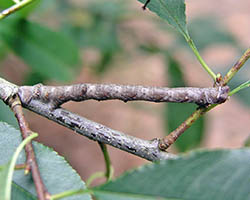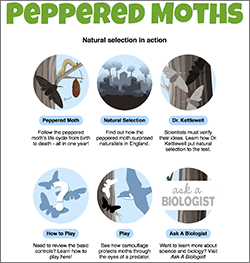5. What Factors Might Influence The Type Of Animals A Barn Owl Preys On?
Written by: Ronald Rutowski and Sean Hannam
Illustrated by: Sabine Deviche
Blending In
You walk over the tan-colored sand of the empty desert. You are mid-stride through a fix when a rattlesnake appears out of the sand in front of you lot, rattling its tail. Luckily it had warned you of its presence. This snake matched its surroundings well-nigh perfectly, making it very difficult to run across.

Camouflage is an appearance or behavior that helps something blend in with the surrounding environs. Click for more detail.
The ability for animals to alloy in is what helps many avoid being eaten past predators. For others, it is what helps them catch unsuspecting prey.
Imagine if that aforementioned snake were moved to a green leafy rainforest. The colors that helped the snake blend into the desert will make it stand out against the green environment. It will no longer be camouflaged.
This merely goes to show you that camouflage doesn't work everywhere. What helps you hide in 1 identify might make you stand out in others. So what happens when an creature's environment changes? Permit's accept a look at one animate being species that is famous for irresolute over time to stay camouflaged: the peppered moth.
A Pick of Pepper

The caterpillar of the peppered moth can blend in on some trees, looking like a twig. Click for more than item.
Like many insects, the peppered moth can do good from blending into its environment. This means its coloration should match with the copse on which it perches. So, what would happen if the trees began changing, and the peppered moths were no longer able to alloy in?
Information technology could adapt to these changes in a number of ways. The individuals could move (to try to find trees that match its color). Or the species could have altered behavior, or even modify over time to adapt to the new environment.
This species has two dissimilar adult forms. I form of the species, typica, is a pale lighter color that is peppered with black speckles. The other course,carbonaria, is a much darker colour that is peppered with light speckles.
From Calorie-free to Dark Moths
Moth collectors in England noted that near brindled moths collected in the early 1800's were light greyness peppered with bits of black. Many years later most of the moths collected were almost completely black.

Most of the peppered moths nerveless in the early 1800s were the light form. Click for more detail.
What could have acquired the more common light colored moth to become rare?
Scientists bred the moths and figured out that the light-colored class of the peppered moth has different genes from the night class. The black color of the dark class was due to a mutation in the DNA of the light-colored form.
One time this mutation was present, the dark-colored moths would produce offspring with night-colored wings. Lite colored adults that didn't take the mutation produced light offspring. But genetics is but part of the story.
A Changing Globe
During the 1800's, Europe and America experienced the Industrial Revolution. Information technology was a time of change in manufacturing processes that led to the building of factories.This enabled humans to make many more things much faster.
In the 1800s, manufacturing processes changed. Click for more detail.
We went from a largely rural club to a city or urban one. One of the new fuel sources that was heavily used during this time menses was coal. Minor amounts of coal tin can produce large amounts of heat. It well-nigh replaced woods in many homes in Europe during this time. It was used for heating homes and cooking and it became the chief free energy source in factories.
Coal burning released large amounts of smoke and smog into the surrounding environment.This left a layer of blackness soot on the in one case lighter-colored copse. The pollution also killed the low-cal speckled colored lichens that grew on the tree trunks. The tree bawl was at present exposed and dark without the lichens. How did this affect the peppered moth?
The Pepper in Brindled Moth
Like many moths in forests, the peppered moth tends to balance (or "perch") on tree trunks during the solar day. They practice nigh of their flying at night. So it would probably be a good thing if the moths look similar to the copse that they perch on, right? So they tin can be camouflaged from birds that desire to consume them.
Before the Industrial Revolution, the lite peppered moth was common, while the nighttime form was very rare. The low-cal moths composite in with the lite-colored copse. However, the Industrial Revolution changed the tree colors.

After the pollution from the Industrial Revolution started affecting trees, most of the collected brindled moths were of the night form. Click for more detail.
As the copse darkened with soot, the lite-colored moths were easier to encounter. They were eaten by birds more than and more, while the rare nighttime colored moths blended in better on the darker trees. This made the dark colored moths accept a higher survival rate. They lived longer and passed their nighttime colored genes onto their offspring or young.
Natural Selection in Action
Over fourth dimension, the nighttime colored moths became the more than mutual of the ii colour forms. Natural pick favored the dark individuals, and then they were more successful after the trees changed.
Sound a niggling hard to believe? Well, more observations accept come about since these conditions started to reverse, starting in the 1950s. Then, a Clean Air Act was introduced. Since that fourth dimension, technology and cleaner burning fuels have started to decrease pollution in the areas where the brindled moth lives. The lichen has started to grow again and the black soot no longer settles on the barks of the copse. As expected, the light peppered moth population has recently been more common in the population. This is because it is meliorate camouflaged.
Changing Colors

Dr. Kettlewell wanted to know if natural option was driving the change in moths. Click to visit the game page and learn more than.
Biologists are curious nearly why coloration can differ amidst individuals in a species. Many scientists want to look at both how and why a species may modify over time.
Scientists like Dr. Henry Bernard Davis Kettlewell used the Scientific Method to exam how and why brindled moth coloration inverse.
Visit Picking Off the Peppered Moth to acquire more.
Need the old version? Click for the Flash version of the Brindled Moth game.
Images via Wikimedia Commons. Camouflaged spider by Matthias M.
Source: https://askabiologist.asu.edu/peppered-moth
Posted by: stricklandwhousen.blogspot.com

0 Response to "5. What Factors Might Influence The Type Of Animals A Barn Owl Preys On?"
Post a Comment